+ Open data
Open data
- Basic information
Basic information
| Entry | Database: PDB / ID: 4hwi | ||||||
|---|---|---|---|---|---|---|---|
| Title | Crystal structure of ATBAG1 in complex with HSP70 | ||||||
 Components Components |
| ||||||
 Keywords Keywords | CHAPERONE/APOPTOSIS / BAG domain / ubiquitin-like domain / co-chaperone / complex with molecular chaperone / CHAPERONE-APOPTOSIS complex | ||||||
| Function / homology |  Function and homology information Function and homology informationlumenal side of lysosomal membrane / regulation of protein import / negative regulation of supramolecular fiber organization / chaperone-mediated autophagy translocation complex disassembly / clathrin-sculpted gamma-aminobutyric acid transport vesicle membrane / Lipophagy / Respiratory syncytial virus genome transcription / GABA synthesis, release, reuptake and degradation / protein targeting to lysosome involved in chaperone-mediated autophagy / protein carrier chaperone ...lumenal side of lysosomal membrane / regulation of protein import / negative regulation of supramolecular fiber organization / chaperone-mediated autophagy translocation complex disassembly / clathrin-sculpted gamma-aminobutyric acid transport vesicle membrane / Lipophagy / Respiratory syncytial virus genome transcription / GABA synthesis, release, reuptake and degradation / protein targeting to lysosome involved in chaperone-mediated autophagy / protein carrier chaperone / cytoplasm protein quality control by the ubiquitin-proteasome system / clathrin coat disassembly / C3HC4-type RING finger domain binding / CHL1 interactions / regulation of protein complex stability / negative regulation of NLRP3 inflammasome complex assembly / ATP-dependent protein disaggregase activity / membrane organization / protein folding chaperone complex / Lysosome Vesicle Biogenesis / cellular response to steroid hormone stimulus / chaperone-mediated autophagy / Golgi Associated Vesicle Biogenesis / non-chaperonin molecular chaperone ATPase / : / Prp19 complex / Regulation of HSF1-mediated heat shock response / HSF1-dependent transactivation / response to unfolded protein / regulation of protein-containing complex assembly / Attenuation phase / ATP metabolic process / Protein methylation / heat shock protein binding / protein folding chaperone / mRNA Splicing - Major Pathway / lysosomal lumen / HSP90 chaperone cycle for steroid hormone receptors (SHR) in the presence of ligand / cellular response to starvation / AUF1 (hnRNP D0) binds and destabilizes mRNA / spliceosomal complex / ATP-dependent protein folding chaperone / Late endosomal microautophagy / G protein-coupled receptor binding / mRNA splicing, via spliceosome / PKR-mediated signaling / regulation of protein stability / Chaperone Mediated Autophagy / MHC class II protein complex binding / unfolded protein binding / melanosome / protein folding / protein-folding chaperone binding / Clathrin-mediated endocytosis / protein refolding / secretory granule lumen / Interleukin-4 and Interleukin-13 signaling / protein-macromolecule adaptor activity / blood microparticle / ficolin-1-rich granule lumen / positive regulation of cell migration / cadherin binding / receptor ligand activity / ribonucleoprotein complex / lysosomal membrane / focal adhesion / negative regulation of DNA-templated transcription / ubiquitin protein ligase binding / Neutrophil degranulation / nucleolus / enzyme binding / ATP hydrolysis activity / mitochondrion / extracellular space / RNA binding / extracellular exosome / extracellular region / nucleoplasm / ATP binding / nucleus / membrane / plasma membrane / cytosol / cytoplasm Similarity search - Function | ||||||
| Biological species |  Homo sapiens (human) Homo sapiens (human) | ||||||
| Method |  X-RAY DIFFRACTION / X-RAY DIFFRACTION /  SYNCHROTRON / SYNCHROTRON /  MOLECULAR REPLACEMENT / Resolution: 2.273 Å MOLECULAR REPLACEMENT / Resolution: 2.273 Å | ||||||
 Authors Authors | Shen, Y. / Fang, S. | ||||||
 Citation Citation |  Journal: Acta Crystallogr.,Sect.D / Year: 2013 Journal: Acta Crystallogr.,Sect.D / Year: 2013Title: Structural insight into plant programmed cell death mediated by BAG proteins in Arabidopsis thaliana. Authors: Fang, S. / Li, L. / Cui, B. / Men, S. / Shen, Y. / Yang, X. | ||||||
| History |
|
- Structure visualization
Structure visualization
| Structure viewer | Molecule:  Molmil Molmil Jmol/JSmol Jmol/JSmol |
|---|
- Downloads & links
Downloads & links
- Download
Download
| PDBx/mmCIF format |  4hwi.cif.gz 4hwi.cif.gz | 226 KB | Display |  PDBx/mmCIF format PDBx/mmCIF format |
|---|---|---|---|---|
| PDB format |  pdb4hwi.ent.gz pdb4hwi.ent.gz | 180 KB | Display |  PDB format PDB format |
| PDBx/mmJSON format |  4hwi.json.gz 4hwi.json.gz | Tree view |  PDBx/mmJSON format PDBx/mmJSON format | |
| Others |  Other downloads Other downloads |
-Validation report
| Summary document |  4hwi_validation.pdf.gz 4hwi_validation.pdf.gz | 429.6 KB | Display |  wwPDB validaton report wwPDB validaton report |
|---|---|---|---|---|
| Full document |  4hwi_full_validation.pdf.gz 4hwi_full_validation.pdf.gz | 433.3 KB | Display | |
| Data in XML |  4hwi_validation.xml.gz 4hwi_validation.xml.gz | 21.3 KB | Display | |
| Data in CIF |  4hwi_validation.cif.gz 4hwi_validation.cif.gz | 29.7 KB | Display | |
| Arichive directory |  https://data.pdbj.org/pub/pdb/validation_reports/hw/4hwi https://data.pdbj.org/pub/pdb/validation_reports/hw/4hwi ftp://data.pdbj.org/pub/pdb/validation_reports/hw/4hwi ftp://data.pdbj.org/pub/pdb/validation_reports/hw/4hwi | HTTPS FTP |
-Related structure data
| Related structure data | 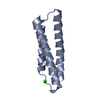 4hwcSC 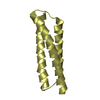 4hwdC 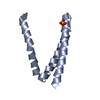 4hwfC  4hwhC 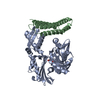 1hx1S S: Starting model for refinement C: citing same article ( |
|---|---|
| Similar structure data |
- Links
Links
- Assembly
Assembly
| Deposited unit | 
| ||||||||
|---|---|---|---|---|---|---|---|---|---|
| 1 |
| ||||||||
| Unit cell |
|
- Components
Components
| #1: Protein | Mass: 41591.020 Da / Num. of mol.: 1 / Fragment: HSP70 ATPase domain (UNP residues 5-381) Source method: isolated from a genetically manipulated source Source: (gene. exp.)  Homo sapiens (human) / Gene: HSC70, HSP73, HSPA10, HSPA8 / Production host: Homo sapiens (human) / Gene: HSC70, HSP73, HSPA10, HSPA8 / Production host:  |
|---|---|
| #2: Protein | Mass: 20185.732 Da / Num. of mol.: 1 / Fragment: BAG domain (UNP residues 66-242) Source method: isolated from a genetically manipulated source Source: (gene. exp.)   |
| #3: Water | ChemComp-HOH / |
-Experimental details
-Experiment
| Experiment | Method:  X-RAY DIFFRACTION / Number of used crystals: 1 X-RAY DIFFRACTION / Number of used crystals: 1 |
|---|
- Sample preparation
Sample preparation
| Crystal | Density Matthews: 2.69 Å3/Da / Density % sol: 54.29 % |
|---|---|
| Crystal grow | Temperature: 277 K / Method: vapor diffusion / pH: 7.5 Details: 0.02 M citric acid / 0.08 M Bis-Tris propane, pH 8.8, 20% PEG3350, VAPOR DIFFUSION, temperature 277K |
-Data collection
| Diffraction | Mean temperature: 100 K | |||||||||
|---|---|---|---|---|---|---|---|---|---|---|
| Diffraction source | Source:  SYNCHROTRON / Site: SYNCHROTRON / Site:  SSRF SSRF  / Beamline: BL17U / Wavelength: 0.9795 / Wavelength: 0.9792 Å / Beamline: BL17U / Wavelength: 0.9795 / Wavelength: 0.9792 Å | |||||||||
| Detector | Type: ADSC QUANTUM 315r / Detector: CCD / Date: Apr 5, 2011 | |||||||||
| Radiation | Monochromator: double crystal Si(111) / Protocol: SINGLE WAVELENGTH / Monochromatic (M) / Laue (L): M / Scattering type: x-ray | |||||||||
| Radiation wavelength |
| |||||||||
| Reflection | Resolution: 2.273→35.604 Å / Num. all: 30237 / Num. obs: 29495 / % possible obs: 99.2 % / Observed criterion σ(F): 2 / Observed criterion σ(I): 2 | |||||||||
| Reflection shell | Resolution: 2.273→2.34 Å / % possible all: 90.9 |
- Processing
Processing
| Software |
| ||||||||||||||||||||||||||||||||||||||||||||||||||||||||||||||||||||||||||||||||||||
|---|---|---|---|---|---|---|---|---|---|---|---|---|---|---|---|---|---|---|---|---|---|---|---|---|---|---|---|---|---|---|---|---|---|---|---|---|---|---|---|---|---|---|---|---|---|---|---|---|---|---|---|---|---|---|---|---|---|---|---|---|---|---|---|---|---|---|---|---|---|---|---|---|---|---|---|---|---|---|---|---|---|---|---|---|---|
| Refinement | Method to determine structure:  MOLECULAR REPLACEMENT MOLECULAR REPLACEMENTStarting model: PDB ENTRIES 1HX1 AND 4HWC Resolution: 2.273→35.604 Å / SU ML: 0.33 / σ(F): 0 / Phase error: 27.62 / Stereochemistry target values: ML
| ||||||||||||||||||||||||||||||||||||||||||||||||||||||||||||||||||||||||||||||||||||
| Solvent computation | Shrinkage radii: 0.95 Å / VDW probe radii: 1.2 Å / Solvent model: FLAT BULK SOLVENT MODEL / Bsol: 28.363 Å2 / ksol: 0.376 e/Å3 | ||||||||||||||||||||||||||||||||||||||||||||||||||||||||||||||||||||||||||||||||||||
| Displacement parameters |
| ||||||||||||||||||||||||||||||||||||||||||||||||||||||||||||||||||||||||||||||||||||
| Refinement step | Cycle: LAST / Resolution: 2.273→35.604 Å
| ||||||||||||||||||||||||||||||||||||||||||||||||||||||||||||||||||||||||||||||||||||
| Refine LS restraints |
| ||||||||||||||||||||||||||||||||||||||||||||||||||||||||||||||||||||||||||||||||||||
| LS refinement shell |
| ||||||||||||||||||||||||||||||||||||||||||||||||||||||||||||||||||||||||||||||||||||
| Refinement TLS params. | Method: refined / Origin x: -3.9841 Å / Origin y: 11.2972 Å / Origin z: -12.5329 Å
| ||||||||||||||||||||||||||||||||||||||||||||||||||||||||||||||||||||||||||||||||||||
| Refinement TLS group | Selection details: all |
 Movie
Movie Controller
Controller



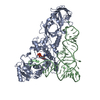
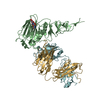
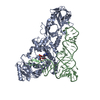
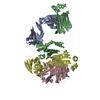
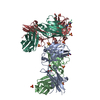
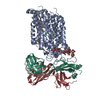
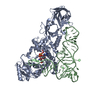
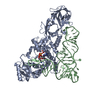

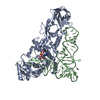
 PDBj
PDBj

















